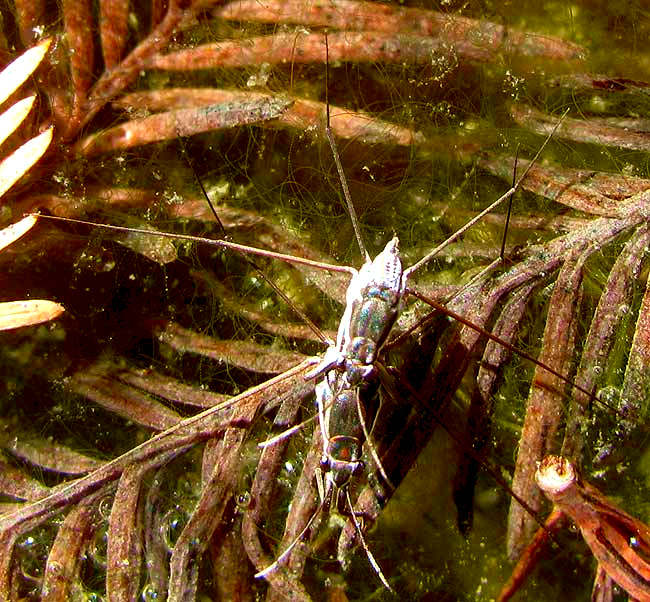Excerpts from Jim Conrad's
Naturalist Newsletter

from the December 29, 2013 Newsletter issued from the Frio Canyon Nature Education Center in the valley of the Dry Frio River in northern Uvalde County, southwestern Texas, on the southern border of the Edwards Plateau; elevation ~1750m (~5750 ft); N29.62°, W99.86°; USA
LITTLE WATER STRIDER
After several hard freezes I wasn't expecting to find much animal life around the little pool attached to a stretch of the intermittent Dry Frio's running water. However, something small enough that I couldn't quite make it out with my foggy vision was skating across the water's surface, so I set the camera on automatic, held it above the critter, and got what's shown above.
It's two critters instead of one and though they don't seem to be mating, at least the one on top appears to be enjoying a free ride. They're water striders, but not the regular, much larger species. You can judge how tiny they are by the featherlike Baldcypress leaf beneath them.
Anatomically they are similar enough to the larger Common Water Strider, genus Gerris, to guess that they're in the same family. However, their body sections are different enough from Common Water Striders that probably they belong to a separate genus. Thinking like that as I browsed around, finally it became clear that we have NEOGERRIS HESIONE, and though it's found from New York Michigan and Nebraska south to Florida and Texas, as well as in Cuba and Central America, it bears no common name I can find. That's a shame, so here we'll name it the Little Water Strider.
In fact, compared to other water strider species, Neogerris hesione has very little information published about its life history. One feature that is known, however, is that individuals come in both wingless, or "apterous," and winged, or "macropterous," editions. Ours are wingless. This fits in with a 1958 study by C.A. Wilson reporting that 95% of adults in Mississippi were apterous, or wingless.
It's known that couples of Little Water Striders may travel as shown in the picture, together but not mating, both before and after mating, and they do this for some days.
I think we're making a small contribution here by documenting the fact that in our part of the world Neogerris hesione couples may be observed skating together in late December -- December 22, to be exact.